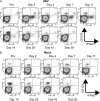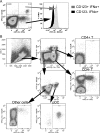Modulation of type I interferon-associated viral sensing during acute simian immunodeficiency virus infection in African green monkeys
- PMID: 25355871
- PMCID: PMC4301160
- DOI: 10.1128/JVI.02430-14
Modulation of type I interferon-associated viral sensing during acute simian immunodeficiency virus infection in African green monkeys
Abstract
Natural hosts of simian immunodeficiency virus (SIV), such as African green monkeys (AGMs), do not progress to AIDS when infected with SIV. This is associated with an absence of a chronic type I interferon (IFN-I) signature. It is unclear how the IFN-I response is downmodulated in AGMs. We longitudinally assessed the capacity of AGM blood cells to produce IFN-I in response to SIV and herpes simplex virus (HSV) infection. Phenotypes and functions of plasmacytoid dendritic cells (pDCs) and other mononuclear blood cells were assessed by flow cytometry, and expression of viral sensors was measured by reverse transcription-PCR. pDCs displayed low BDCA-2, CD40, and HLA-DR expression levels during AGM acute SIV (SIVagm) infection. BDCA-2 was required for sensing of SIV, but not of HSV, by pDCs. In acute infection, AGM peripheral blood mononuclear cells (PBMCs) produced less IFN-I upon SIV stimulation. In the chronic phase, the production was normal, confirming that the lack of chronic inflammation is not due to a sensing defect of pDCs. In contrast to stimulation by SIV, more IFN-I was produced upon HSV stimulation of PBMCs isolated during acute infection, while the frequency of AGM pDCs producing IFN-I upon in vitro stimulation with HSV was diminished. Indeed, other cells started producing IFN-I. This increased viral sensing by non-pDCs was associated with an upregulation of Toll-like receptor 3 and IFN-γ-inducible protein 16 caused by IFN-I in acute SIVagm infection. Our results suggest that, as in pathogenic SIVmac infection, SIVagm infection mobilizes bone marrow precursor pDCs. Moreover, we show that SIV infection modifies the capacity of viral sensing in cells other than pDCs, which could drive IFN-I production in specific settings.
Importance: The effects of HIV/SIV infections on the capacity of plasmacytoid dendritic cells (pDCs) to produce IFN-I in vivo are still incompletely defined. As IFN-I can restrict viral replication, contribute to inflammation, and influence immune responses, alteration of this capacity could impact the viral reservoir size. We observed that even in nonpathogenic SIV infection, the frequency of pDCs capable of efficiently sensing SIV and producing IFN-I was reduced during acute infection. We discovered that, concomitantly, cells other than pDCs had increased abilities for viral sensing. Our results suggest that pDC-produced IFN-I upregulates viral sensors in bystander cells, the latter gaining the capacity to produce IFN-I. These results indicate that in certain settings, cells other than pDCs can drive IFN-I-associated inflammation in SIV infection. This has important implications for the understanding of persistent inflammation and the establishment of viral reservoirs.
Copyright © 2015, American Society for Microbiology. All Rights Reserved.
Figures






Similar articles
-
Plasmacytoid Dendritic Cell Infection and Sensing Capacity during Pathogenic and Nonpathogenic Simian Immunodeficiency Virus Infection.J Virol. 2015 Jul;89(13):6918-27. doi: 10.1128/JVI.00332-15. Epub 2015 Apr 22. J Virol. 2015. PMID: 25903334 Free PMC article.
-
Rapid Development of gp120-Focused Neutralizing B Cell Responses during Acute Simian Immunodeficiency Virus Infection of African Green Monkeys.J Virol. 2015 Sep;89(18):9485-98. doi: 10.1128/JVI.01564-15. Epub 2015 Jul 8. J Virol. 2015. PMID: 26157116 Free PMC article.
-
Nonpathogenic SIV infection of African green monkeys induces a strong but rapidly controlled type I IFN response.J Clin Invest. 2009 Dec;119(12):3544-55. doi: 10.1172/JCI40093. J Clin Invest. 2009. PMID: 19959873 Free PMC article.
-
SIVagm: genetic and biological features associated with replication.Front Biosci. 2003 Sep 1;8:d1170-85. doi: 10.2741/1130. Front Biosci. 2003. PMID: 12957815 Review.
-
SIVagm infection of its natural African green monkey host.Immunol Lett. 1996 Jun;51(1-2):53-8. doi: 10.1016/0165-2478(96)02555-2. Immunol Lett. 1996. PMID: 8811345 Review.
Cited by
-
Type I interferon: understanding its role in HIV pathogenesis and therapy.Curr HIV/AIDS Rep. 2015 Mar;12(1):41-53. doi: 10.1007/s11904-014-0244-6. Curr HIV/AIDS Rep. 2015. PMID: 25662992 Review.
-
Plasmacytoid Dendritic Cell Infection and Sensing Capacity during Pathogenic and Nonpathogenic Simian Immunodeficiency Virus Infection.J Virol. 2015 Jul;89(13):6918-27. doi: 10.1128/JVI.00332-15. Epub 2015 Apr 22. J Virol. 2015. PMID: 25903334 Free PMC article.
-
Lymph Node Cellular and Viral Dynamics in Natural Hosts and Impact for HIV Cure Strategies.Front Immunol. 2018 Apr 19;9:780. doi: 10.3389/fimmu.2018.00780. eCollection 2018. Front Immunol. 2018. PMID: 29725327 Free PMC article. Review.
-
Plasmacytoid dendritic cells sense HIV replication before detectable viremia following treatment interruption.J Clin Invest. 2020 Jun 1;130(6):2845-2858. doi: 10.1172/JCI130597. J Clin Invest. 2020. PMID: 32017709 Free PMC article. Clinical Trial.
-
Friend or Foe: Innate Sensing of HIV in the Female Reproductive Tract.Curr HIV/AIDS Rep. 2016 Feb;13(1):53-63. doi: 10.1007/s11904-016-0305-0. Curr HIV/AIDS Rep. 2016. PMID: 26879654 Free PMC article. Review.
References
-
- Fonteneau J-F, Larsson M, Beignon A-S, McKenna K, Dasilva I, Amara A, Liu Y-J, Lifson JD, Littman DR, Bhardwaj N. 2004. Human immunodeficiency virus type 1 activates plasmacytoid dendritic cells and concomitantly induces the bystander maturation of myeloid dendritic cells. J Virol 78:5223–5232. doi:10.1128/JVI.78.10.5223-5232.2004. - DOI - PMC - PubMed
-
- Romagnani C, Della Chiesa M, Kohler S, Moewes B, Radbruch A, Moretta L, Moretta A, Thiel A. 2005. Activation of human NK cells by plasmacytoid dendritic cells and its modulation by CD4+ T helper cells and CD4+ CD25hi T regulatory cells. Eur J Immunol 35:2452–2458. doi:10.1002/eji.200526069. - DOI - PubMed
-
- Karpov AV. 2001. Endogenous and exogenous interferons in HIV-infection. Eur J Med Res 6:507–524. - PubMed
-
- Asmuth DM, Murphy RL, Rosenkranz SL, Lertora JJ, Kottilil S, Cramer Y, Chan ES, Schooley RT, Rinaldo CR, Thielman N, Li XD, Wahl SM, Shore J, Janik J, Lempicki RA, Simpson Y, Pollard RB. 2010. Safety, tolerability, and mechanisms of antiretroviral activity of pegylated interferon Alfa-2a in HIV-1-monoinfected participants: a phase II clinical trial. J Infect Dis 201:1686–1696. doi:10.1086/652420. - DOI - PMC - PubMed
Publication types
MeSH terms
Substances
LinkOut - more resources
Full Text Sources
Other Literature Sources
Molecular Biology Databases
Research Materials

